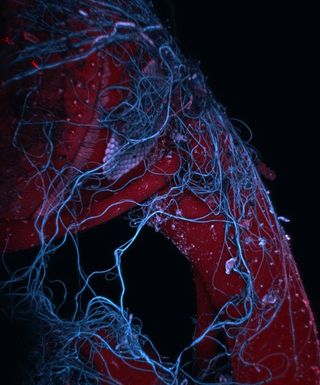
This amazing image is actually of an insect wrapped up in a spider web took ninth place at Nikon's 2013 Small World Photomicrography competition.
Mark A. Sanders from University Imaging Centers, University of Minnesota in Minneapolis, Minn. submitted the photo, which was created from stacked images magnified 85 times. He used autofluorescence and confocal optical imaging technique to capture the false-color photo.
Autofluorescence is the natural emission of light by biological structures when exposed to light they absorb, in this case the insect and spider web. Most biological structures and even some synthetic products, such as paper, have some degree of autofluorescence. Autofluorescence from U.S. paper currency is used to discern counterfeit from authentic money.
Sanders other technique, confocal optical imaging, is used to improve detail in an image by eliminating out-of-focus signals from the microscope. A conventional microscope "sees" as far into the specimen as the light can penetrate, while a confocal microscope only "sees" images one depth level at a time making each more controlled and focused. By stacking several images, Sanders is able to get a close-up view.
Follow LiveScience @livescience, Facebook & Google+.
Sign up for the Live Science daily newsletter now
Get the world’s most fascinating discoveries delivered straight to your inbox.

